The narrator of Elie Wiesel’s Night is a precocious student whose love of God is so profound, he weeps during prayer. At only 13, he wants to study Kabbalah: Jewish mystical teachings, usually reserved for more mature scholars. Against the wishes of his father, he finds a teacher who can instruct him in Kabbalah, and spends his days in study and prayer. It’s this teacher of Kabbalah, Moishe the Beadle, a foreigner, who is among the first in the town to be deported by the Nazis, and when he miraculously returns, tries in vain to warn people about what is in store for them. They refuse to believe an eccentric old man and, eventually, the inevitable happens: the Jews of the town are placed into ghettos, packed into boxcars, and transported to Auschwitz. By the first night in the camp, having witnessed babies and children thrown into a pit and burned, young Eliezer no longer loves God; he rages against whatever force has torn him from his home and family, and condemned him to witness such horrors.
I first read Wiesel’s book in my late twenties, and when I was finished, immediately turned to Primo Levi’s Survival in Auschwitz. Levi’s narrator is a fighter in the Italian resistance who is older and more hardened than Wiesel’s devout child; yet, he too is broken by his experience in the camps. The process of turning a man into a prisoner, Levi reflects, strips him of love and identity, and reduces him to nothing. “Imagine now a man,” Levi writes: “who is deprived of everyone he loves, and at the same time of his house, his habits, his clothes, in short, of everything he possesses: he will be a hollow man, reduced to suffering and needs, forgetful of dignity and restraint, for he who loses all often easily loses himself.” The new prisoners, freshly shaved and dressed in striped prisoners’ uniforms, look at one another and Levi, still reflective, realizes “our language lacks words to express this offence, the demolition of a man.” And after I read Levi’s account of his own demolition, I went on to read other Holocaust stories, each one riveting in its own way, though they often followed the same pattern: ghetto, deportation, arrival at the camp, impossible work, starvation, dehumanization.
Friends began to look at me with some concern and to suggest that Holocaust narratives might be depressing. But I read them as an antidote to depression. They gave me a perverse kind of relief from my everyday concerns: a flopped class presentation, one more regrettable evening with the man I wasn’t really dating, too many cookies. Holocaust stories immersed me in a world that was truly in crisis; the misery of victims was more engrossing than any other imagined experience, held my attention more completely. I needed full-blown, life-and-death suffering. I read Holocaust narratives while riding the subway or sitting in cafes, in between classes and before I went to bed. These stories, and nothing else, held my attention.
It wasn’t just that the stories were gripping; they were also my inheritance, my fate. Until that point, I had kept my gaze averted from the historical disaster; now, I was finally confronting it. Growing up among refugees from Nazi Germany, I regarded the topic of the Holocaust in much the same way as I regarded the subject of cholesterol, which came up at the dinner table with about the same frequency. (They even seemed like anagrams.) Traumatic death from the outside; creeping death from the inside. I saw both topics as adult concerns: remote, invisible, and frightening. The very word “Holocaust” filled me with distaste.
These conversations, tacking between the Holocaust and cholesterol, happened at Thanksgiving or Passover, at my parents’ home in Connecticut, or at my aunt and uncle’s in Utica. My mother had limited tolerance for talk about the Holocaust: the fate of survivors, donations for memorials. She avoided books and movies about the Holocaust, which were beginning to proliferate. At home, when the subject came up, she might leave the room on the pretext of putting on water for tea.
I followed her out of the room, clamping my mind shut whenever the subject came up. I was the rare child who was not made to read Anne Frank’s diary in school—perhaps that would have changed my attitude. But photos of her were unavoidable, and I was unsettled by the resemblance between Anne Frank, as she appears in photographs at age 14, and the black-and-white images of my mother at the same age. They were identical. And later, it was my mother’s proximity to the Holocaust that preoccupied me most—the fact that she could have been, almost was, Anne Frank.
At the very beginning of my Holocaust phase, I read a book by an Israeli psychoanalyst, Dina Wardi, called Memorial Candles: Children of the Holocaust. According to Wardi’s theory, one child in the family was typically singled out to bear the burden of memory. She even offered several examples of “memorial candles” who were anorexic, as I had been as a teenager. This book convinced me that my mother fit the psychological profile of a Holocaust survivor, and that I was the family’s “memorial candle.”
I discovered suddenly that it was not being a woman that made me unhappy: it was being a Jew. For fifteen years, I had looked to feminist theory and psychoanalysis as offering the best explanations for my persistent, low-grade depression: women were not taught to differentiate themselves from their mothers; daughters felt that eating depleted or wounded their mothers; women were taught to keep a strict watch over themselves, measuring their self-worth according to their attractiveness to men; women learned that self-abnegation was the highest form of virtue; women were terrified of displeasing others. By the late 90s, these ideas were losing their force for me (my brothers, after all, struggled just as I did). Feminist theory was mutating into gender studies and queer theory, but more important: I was still depressed, anxious, and obsessed with controlling my eating. All that psychotherapy and reading of feminist theory had not made much difference in my sanity, and finally, I was looking for other explanations.
The rising American obsession shaped my search. The United States Holocaust Memorial and Museum in Washington, DC opened in 1994; Stephen Spielberg’s Schindler’s List won an Oscar in the same year. I remember seeing the film for the first time and emerging from the theater reeling with the force of the revelation. It was not the tyranny of gender, but something else entirely that caused my suffering: it was my inheritance as the child of a Holocaust survivor. My mother wasn’t exactly a survivor: although she was born in Nazi Germany, she left with her immediate family in 1936 and emigrated first to London and then to Philadelphia. She was never in a camp, but she considered herself a survivor and suffered the maladies of survivors. I learned the phrase “intergenerational transmission of trauma,” which suddenly had greater power of explanation that all the feminist theory I had imbibed over the years.
The epiphany—the certainty that the inheritance of trauma made me miserable—meant that I could not continue working in the field of feminist theory, but had to give it up and pursue this new course of study. With almost no background in the field, starting entirely from scratch, I proposed a dissertation on the representation of the Holocaust in the United States. In its early stages, the dissertation’s true purpose as a medium for self-analysis was poorly masked. I wrote an opening chapter based on “interviews” with my mother about her earliest memories—memories of Germany confined to the inside of an apartment. Fortunately, I abandoned that chapter after a few months. As I continued to work on the project, especially with a group of other graduate students, it came to look less nakedly like self-analysis. Still, when one of my advisors read an early draft, he remarked, “Everyone is working through something.” He meant: don’t be so ridiculously explicit about it.
But the Holocaust as a dissertation topic opened up a surprising source of pleasure: studying German. I had a year of college German, from the delusional period when I thought I might become serious about continental philosophy. I had lived in Germany for nine months with a boyfriend who was serious about continental philosophy. At about the same time I began reading Holocaust narratives, I began taking German again, and it became an unexpected joy. I simply loved the language and, when I had acquired some proficiency, the literature. And then, just when a serious relationship was ending and I was especially weary of my dissertation, I got a grant to study German at the Goethe Institute in Dresden.
***
The scholarship agency had assigned me to Dresden. Americans remember Dresden as the city we firebombed to destroy German pride. I knew it was in the former East and vaguely connected it with classical music (probably because of its famous opera house, the Semperoper). That was all I knew of Dresden until I arrived in the taxi from the airport, and gasped at the beauty of the Gothic spires, black against the sky.
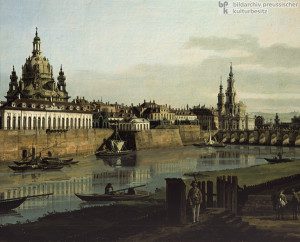 On the first day of the course, we assembled in the hallway of the Goethe Institute. with all the other students: mostly Americans, some Japanese, a Dutch person here and there. They were trying German, then resorting to English. Students went in one by one to have their first conversation with a teacher. Someone stepped into the hallway and I looked up and met his eyes, which were blue.
On the first day of the course, we assembled in the hallway of the Goethe Institute. with all the other students: mostly Americans, some Japanese, a Dutch person here and there. They were trying German, then resorting to English. Students went in one by one to have their first conversation with a teacher. Someone stepped into the hallway and I looked up and met his eyes, which were blue.
“Gibt es eine Ordnung?” I asked him. Is there an order? “Chaos ist die Ordnung,” he replied: chaos is the order. I followed him into the classroom.
In our first conversation, I told him that my dissertation was on the Holocaust. Perhaps I even told him that my mother is a survivor. He was a tall, slender man who dressed meticulously in linen slacks and button-down shirts, sandals. He had a high forehead and an aquiline nose, wore his fair hair shaved almost to the skull and a faint mustache. He was alert, quick, tense. I will call him Stefan.
I was placed in his section, the most advanced. I was terribly excited to begin, but almost as soon as the course began, it was clear we were an impossible class. We divided ourselves down the middle, with three nerdy graduate students on one side (myself included) and three undergraduates with attitude on the other. The graduate students did their homework, went to bed early, and rose early to exercise. I arrived for class with my hair still wet from swimming, and another grad student was often fresh from his run. The undergraduates stayed out late drinking in Kneipes and barely managed to keep their eyes open in class.
There was no way to satisfy us all: if an exercise was meant to be fun, it struck us as childish and we rolled our eyes; if it involved grammar exercises, it was tedious and we always knew who would get it right or wrong; if we read literature, some of us were lost, others discontented (I was happy); if our teacher asked us to do presentations, some cooperated while others simply refused. He had no recourse, since there were no grades.
As the class went on, I watched his despair grow, and as a teacher myself, became furious on his behalf. I wanted to reprimand the other students. They resented me for dominating the class. Whenever there was a silence, I jumped in to rescue him. All my talking created more silence, which I then had to fill in. If we weren’t going around the table offering answers to grammar exercises in turn, then the class often devolved into a conversation between me and Stefan.
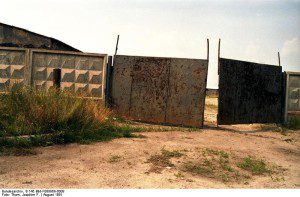 Our classroom window looked out on a wasteland, a muddy vacant lot with weeds and garbage. Once, while I lingered in the classroom on a break, Stefan and I both looked out at this dismal landscape. The Soviet barracks had stood there, he explained: the very site of the Goethe Institute filled him with historical melancholy, the inverse of nostalgia. Slowly, haltingly, I began to ask him about his past, which was tied up with the history of Dresden and East Germany, reunification and its complex aftermath. He had grown up under the Soviet regime, served his mandatory time in the military, participated in protests against the regime, and celebrated the demise of the Soviet Union and the reunification of Germany.
Our classroom window looked out on a wasteland, a muddy vacant lot with weeds and garbage. Once, while I lingered in the classroom on a break, Stefan and I both looked out at this dismal landscape. The Soviet barracks had stood there, he explained: the very site of the Goethe Institute filled him with historical melancholy, the inverse of nostalgia. Slowly, haltingly, I began to ask him about his past, which was tied up with the history of Dresden and East Germany, reunification and its complex aftermath. He had grown up under the Soviet regime, served his mandatory time in the military, participated in protests against the regime, and celebrated the demise of the Soviet Union and the reunification of Germany.
On breaks, I remained in the classroom, hoping Stefan would stay and talk with me. Meanwhile, the impossible class continued. Claudia, a Dutch girl who spoke perfect German, corrected me when I made an error with endings or prepositions, which I did in almost every sentence. “Sei nicht so pingelig,” Stefan teased her: “Don’t be so pedantic.”
Claudia corrected me once again and I apologized, “Ich bin hoffnungslos,” meaning “I’m hopeless.”
Stefan corrected me: “Ich bin ein hoffnungsloser Fall.” I am a hopeless case.
I turned back to Claudia, “Ich bin ein hoffnungsloser Fall.”
We practiced prepositions endlessly and I failed to make any progress, we learned the subjunctive for indirect discourse and for hypothetical situations. Stefan taught us a song in the subjunctive. It began:
Wenn ich ein Vöglein wär,
Und auch zwei Flüglein hätt,
Flög ich zu dir
Weils aber nicht kann sein
Weils aber nicht kann sein,
Bleib ich allhierIf I were a little bird
And had two little wings,
I’d fly to you.
But since it can’t be
But since it can’t be,
I remain here.
In class, we rehearsed the subjunctive song—a song about longing—several times and then sang it for the neighboring class. I sang it to Stefan in my imagination while I was taking a bath in the white-tiled bathroom in my apartment, soaking in pine-smelling bath oil that reminded me of the German Alps. I had begun to think of him with longing.
As a joke, a teacher-in-training taught the neighboring class Communist songs, and we could hear them singing heartily. Stefan’s face darkened. It was rumored that Stefan made them stop, and they resented him because they enjoyed singing Communist songs.
***
I had already fallen in love with Dresden. From the first day, I was bewitched by the way the blackened silhouettes of the Gothic buildings stood out against the sky. (They were made of a porous material, sandstone, which easily absorbed pollution, which was why they became black.) 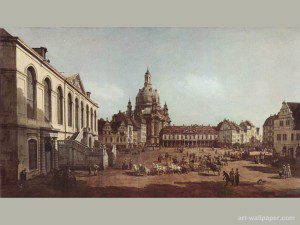 The Elbe river traced a curved path through the center of the city, with the Altstadt on one side and the Neustadt on the other. In the Altstadt were the most breathtaking old Gothic buildings, including the Zwinger, a castle that had been converted into an art museum; the Frauenkirche, a cathedral that had been mostly destroyed in the firebombings of WWII, but was now being rebuilt, the blackened stones incorporated into the façade; the Semperoper, a famous opera house, where we went to see The Magic Flute; a promenade called the Bruehlische Terrace ran along the edge of the Elbe. Yellow trolleys hummed through the streets. My heart ached with love for this fairytale city.
The Elbe river traced a curved path through the center of the city, with the Altstadt on one side and the Neustadt on the other. In the Altstadt were the most breathtaking old Gothic buildings, including the Zwinger, a castle that had been converted into an art museum; the Frauenkirche, a cathedral that had been mostly destroyed in the firebombings of WWII, but was now being rebuilt, the blackened stones incorporated into the façade; the Semperoper, a famous opera house, where we went to see The Magic Flute; a promenade called the Bruehlische Terrace ran along the edge of the Elbe. Yellow trolleys hummed through the streets. My heart ached with love for this fairytale city.
I came to know the layout of the Galleries, both the Old Masters and the New Masters. Some great weight seemed to lift from my heart as I walked alone in these galleries. A feeling very like spiritual joy overcame me, a capacity for happiness I never experienced before or since. I left the gallery, walked on the Bruehlische Terrace in the warm sun and watched children eating ice cream cones, which their parents bought them from little carts. I watched the tour boats gliding by on the Elbe, with tourists drinking beer. Later, I took the boat myself to visit Pilnitz, the lovely park on the grounds of the summer castle, belonging to the ruling family of Saxony.
Perhaps the city looked more poignantly lovely because I was conscious of its tragic history. In the gift shop of the Galerie Neue Meister, you could buy postcards or albums with photos of Dresden after the bombing. In one particularly memorable image, a caped figure atop the city hall extends her hand as if expressing sorrow and disbelief at the ruined city. In other photos, great heaps of stone fill the streets,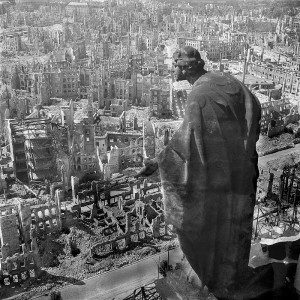 lying against the remains of the magnificent buildings.
lying against the remains of the magnificent buildings.
I re-read the most famous book about the firebombing of Dresden, Kurt Vonnegut’s Slaughterhouse Five. (I’d read it for the first time in high school, for a report on Kurt Vonnegut.) The novel has an antic tone, skipping from satirical science fiction to the tragic absurdities of war. The protagonist, Billy Pilgrim, looks like a clown, but has a gentle dignity; he’s helpless, a child buffeted by the circumstances of war. Never especially enthusiastic about living, Billy begs to be left behind in the snow, rather than pushed and dragged along by a fellow soldier, who leads him into the hands of German soldiers. They transport the POWs by boxcar to a meat locker in Dresden.
The firebombing takes place on the night of February 13th, 1945. Below ground in the meat locker, Billy hears “giant footsteps,” the sound of bombs detonating. The German guards who watch over their American prisoners look up the stairs periodically to see what is happening outside, and Dresden is “one big flame. The one flame ate everything organic, everything that would burn.” At noon the next day, the prisoners emerge in a moonscape. “Everybody else in the neighborhood was dead,” the narrator observes. From a distance, the heaps of rubble look like “graceful curves,” but when the survivors get closer, they turn out to be “treacherous, jagged things—hot to touch, often unstable.” They climb over these jagged heaps to the outskirts of the city, where an innkeeper gives them soup and lets them sleep in a stable. In the days after the bombing, Billy takes part in the excavation of “corpse mines”: bodies concealed in spaces beneath the rubble.
135, 000 people died in the Dresden firebombing.
For some time after re-reading Slaughterhouse Five, I walked around with the images of destruction superimposed on the bright little city. I loved Dresden because it was a battered place, slowly regaining its former beauty.
In 1998, Dresden was a historical palimpsest, with layers of the past imperfectly erased. Sublime Gothic buildings dominated the skyline, architecture dating from the period when the kings of Saxony were rich and powerful. A fair number of Soviet-era buildings lined the main streets: severely functional rectangles, grown shabby. Then the new buildings, sparkling with Western money. The Goethe Institute itself was one of these.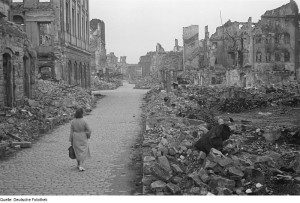 On the brand-new façade of the Institute, someone had spray-painted: Kein Mensch ist Illegal. “No person is illegal,” a slogan in support of Turkish guest-workers and other immigrants—new graffiti, about the politics of unified Germany. Then there was the famous cheese-shop, with its gloriously kitschy mosaics of cherubs, which seemed to belong to some timeless, fairytale Germany.
On the brand-new façade of the Institute, someone had spray-painted: Kein Mensch ist Illegal. “No person is illegal,” a slogan in support of Turkish guest-workers and other immigrants—new graffiti, about the politics of unified Germany. Then there was the famous cheese-shop, with its gloriously kitschy mosaics of cherubs, which seemed to belong to some timeless, fairytale Germany.
I walked around the city in a kind of euphoria, born of enchantment with the place and tenderness towards its inhabitants. And Stefan was the one who embodied its magic most fully for me—Dresden’s vulnerability, refinement, and beauty. Of course I had to get closer to him, as risky as that felt.
On the day we had coffee together, Stefan and I walked away from the Goethe Institute towards a cafe in the Neustadt that he liked. In my purse, I carried a list of questions I could ask him in case there was a lull in the conversation; I had memorized them, but held onto the sheet of paper as a talisman. Without preface, he asked me, “Would you like to see the Jewish cemetery?” He had known since our first conversation that I was from a German-Jewish family and was writing a dissertation on the Holocaust. In class, we watched Hitlerjunge Salomon (in English, known as Europa, Europa), a film about a boy who survives by hiding his Jewish identity and joining the Hitler Youth. I knew that, like many young Germans, Stefan was preoccupied by the Holocaust. Still, I was startled by his suggestion.
The cemetery was nearby, a muddy rectangle the size of a city block. The gate was locked, but Stefan had been there before and knew to go into the adjoining building and speak to the caretaker. She was an elderly Russian Jewish woman, who unlocked the gate for us and handed Stefan a bright blue silk yarmulke. He fitted the skullcap on his head, as if he had momentarily converted for me, and I gave him a look intended to convey gratitude. Lacking language, I tried to convey a lot through expressions, though that was probably inadequate. I felt dizzy. Inside the cemetery, the ground was damp and gave off a swampy odor. Midges flew around our faces.
I held my breath while we walked silently around the perimeter, and wondered why he would bring me here. He was obsessed, I knew, with cemeteries, had studied them and lived across the street from one. Inviting me to visit the Jewish cemetery meant he wanted to mourn with me, to acknowledge the loss of German Jewish life, I thought. But I could not bring myself to speak a question about feelings, could not ask, what are you feeling? or why did you bring me here? or what does it meant to you to be here? We had never discussed feelings before, certainly not his feelings about my Jewishness nor mine about his being German.
I wanted to explain my gratitude, to say how much it moved me to walk there with him. Most of all, I wanted to take his hand. But the tension throttled me, and if I had taken his hand or asked any of questions at the back of my throat, I would have been paralyzed by remorse, and the afternoon would have been ruined. The conditions of the friendship were, I thought, to keep my hands folded under the desk like a good girl, to hold in my aching throat those questions that might have been a breach of decorum.
As I read the names and Hebrew inscriptions on the gravestones, it seemed ironic—even a betrayal—that here in the Jewish cemetery all my emotion was directed towards my German companion, the living man beside me whose inner life was such a compelling mystery, rather than to the Jews buried beneath our feet. They appeared in my imagination, briefly and inaccurately, as a shtetl family in a black-and-white photograph: a bearded patriarch, his stolid wife, and a wide-eyed toddler peering from behind his mother’s skirt. But I felt compassion only towards Stefan, who must have been motivated by guilt that he could never expiate, for crimes he could never undo, to bring his new Jewish friend to the graveyard.
He took off the skullcap as we stepped outside the gate and I closed it. I smiled at him and inhaled deeply into my tight throat and lungs.
***
I landed, temporarily, at my friend Leslie’s apartment in Astoria. My boyfriend and I had given up our place before I left for Germany, and Leslie was away on vacation at the beginning of August, when I returned. The heat was oppressive and my loneliness was sharp. The night I arrived back in New York, I took a bath in Leslie’s tub with the pine-smelling German bath oil that reminded me of the Alps. I sang to Stefan, the song in the subjunctive:
Bin ich gleich weit von dir,
Bin ich doch im Traum bei dir
Und red mit dir.
Wenn ich erwachen tu,
Wenn ich erwachen tu,
Bin ich allein.I’m just as far from you,
But, I’m in a dream with you,
And talk with you.
When I do wake up,
When I do wake up,
I am alone.
After the bath, I took out a book he had recommended, Heinrich Heine’s Winterreise, and read until I could sleep.
Trying to regain my balance in the dizzy heat of New York in late August and September, I forced myself to turn back to schoolwork. At the beginning, first-person accounts of the Holocaust were what moved me most deeply; I was engrossed by individual stories of suffering, of degradation endured and faith broken. I wanted not just to understand the nature of trauma, but to be inside the experience by reading about it. I wanted to feel the powerful touch of the “negative miracle,” as Peter Novick called it.
But it was as if something had permanently shifted on the day I walked through the Jewish cemetery with Stefan. I was no longer interested only in excavating the reasons for my own unhappiness. Loving the German language, the city of Dresden, and Stefan had changed my perspective. Instead of burying myself in first-person narratives, I began to read secondary work: the writing of scholars who saw the rise of Holocaust memorial culture against the background of American politics.
Just as I left the movie theater after Schindler’s List reeling from the force of the story, I closed Peter Novick’s book The Holocaust in American Life stunned by the truths articulated there. I had subscribed to the idea of trauma, both on the individual and the national level: I believed my mother’s early trauma had been passed on to me; I believed that the rising obsession with the Holocaust was the result of a repressed historical trauma. I entered Holocaust discourse as a believer of sorts; now Novick was turning me into a skeptic. Novick argued that the Holocaust, like other collective memories, reflected the cultural and political needs of the present. Why did American Jews—and Americans in general—need the memory of the Holocaust now? Novick offered a compelling list of reasons, ranging from relatively benign to thoroughly unsettling.
He suggested that in the absence of other unifying beliefs or experiences, the Holocaust became the focus of American Jewish identity. (Raised as a secular, “humanist” Jew, with virtually no religious education, that certainly rang true for me.) The Holocaust “filled a need for a consensual symbol.” Identity politics in the 1990s encouraged minorities to jockey for status and “moral privilege” based on victimhood, and the Holocaust was cast as a unique, unprecedented form of victimization.
More troubling was Novick’s observation that the memory of the Holocaust “mandated an intransigent and self-righteous posture in the Israeli-Palestinian conflict.” Here’s where Novick’s argument really began to get under my skin: when he asserted that the American obsession with the Holocaust could undermine progressive values. Most damning of all, Novick associated Holocaust discourse with “the inward and rightward turn of American Jewry in recent decades” and with the loss of the “larger social consciousness” that motivated Jews to participate in the Civil Rights movement. I began to question whether I really wanted to spend all my time focused on “dead Jews.” That was how my friend Ariela, who actually lived a Jewish life, had phrased it.
I had come full circle, back to a deep discomfort with the memory of the Holocaust. This time, it was more than the visceral repulsion I had inherited from my mother. I was still pierced by the faces of Jewish women and children, captured in photographs as they stood on line at train stations with their labeled luggage.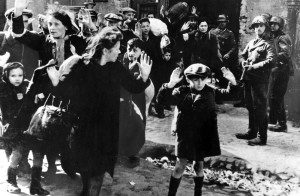 At the same time, I was now sickened by the idea that my work might implicate me in a conservative and self-righteous movement in American Jewish culture. In fact, I could never really imagine myself as a Holocaust scholar, a somber and quasi-rabbinical figure, whose job it was to convey the enormity of the negative miracle.
At the same time, I was now sickened by the idea that my work might implicate me in a conservative and self-righteous movement in American Jewish culture. In fact, I could never really imagine myself as a Holocaust scholar, a somber and quasi-rabbinical figure, whose job it was to convey the enormity of the negative miracle.
Instead, I pictured something else: the Berlin apartment where I had stayed for a few days after leaving Dresden. The place belonged to the friend of a friend, a young doctor who was staying in his other apartment on the outskirts of the city, near the clinic where he worked. His name was Gregor, and he was also an aspiring novelist. I was instantly enamored of the absent Gregor; his neighborhood, Kreuzberg; his shabby two-room apartment. In one room was a bed that struck me as Romanian: compact and high, with a heavy, elaborately carved wooden frame and a faded, handmade quilt. In the other room, a massive table, constructed from a wooden plank laid on two horses. I didn’t dare touch anything on the table, but I walked around it to survey the books, papers, and cigar boxes, some of them empty. Even the empty ones smelled wonderful, earthy and sweet. Around the perimeter of the room, just below the ceiling, was an incomprehensible string of German words. After long contemplation, I concluded it was a Surrealist poem. I wondered what it meant to Gregor.
I stood for a long time before a framed drawing in the bedroom. In the picture, one stick figure stood holding the train of a long cape, worn by another stick figure. The inscription read: “Die Diener des Gegengluecks”: servants of counter-happiness. I would be happy, I was certain, with this Gregor, a fellow servant of counter-happiness. Or being Gregor, writing my own novel, a German-Jewish romance—a story of what could have been, what might still be: a song in the subjunctive.
***
Image credits: featured image, image #2, image #3, image #4, image #5, image #6, image #7.
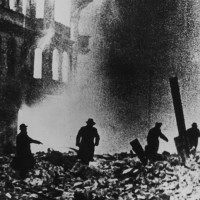




4 responses
A lovely article that reminded me of something. Years ago I was in Poland and my hosts, knowing I was Jewish, asked me the same question: “would you like to see the old Jewish cemetery?” Years later, the same question was asked when visiting friends in Germany. The German cemetery was in the middle of a farm, derelict and filled with weeds. The Polish cemetery, however, had been proudly reconstructed by the city since all the original headstones had been carted off for use as pavement stones in the Konzentrationslagern. All the new headstones were white and shining, polished marble, smooth, all identical with only the Mogen David and no lettering, either Latin or Hebrew. On each stone the name of the person beneath was missing — hundreds of headstones without inscriptions of any kind. Chilling and eerie, each headstone served no purpose individually. The point was the cemetery itself.
Joe, That is chilling and ironic: both the use of the original headstones in the KZ and their replacement with shiny, blank ones. The new stones are interesting as monuments that represent both the presence and the absence of memory, since there are no longer any particular people associated with the stones. I will pass this on to a friend who writes about Holocaust memorialization. Thank you for sharing this, Joe. Best, SF
Dear Sandie:
You are an excellent writer. However, I have issue with your conclusions and overgeneralization of Holocaust “reactivity” as ipso facto leading to poor outcomes. I am a 70 yr old Jewish 2nd gen adult survivor (amongst other identities) & continue to work for social justice out of my understanding that this is a responsibility I inherited by the miracle of my parents’ survival. My daughter, a mother and community activist, continues our family legacy in other ways.
The reality is there was a move away from social activism overall in the US amongst youth and Jewish youth: now that is being reversed, albeit less about civil rights (though that may change) and more in relation to climate change and other causes.
Yes, there are definite dangers when the Holocaust & the death of 6 million is used poorly or to justify the oppression of others, but the reality is that Jews are again threatened (albeit not in the US, in general, despite some incidents). Jews were endangered by the world not paying attention to the Armenian genocide and Hitler saw he could get away with Judenrein. Right now we see new genocides and see the world largely not giving a damn.
We can look to the Holocaust to inspire us in the present and future to do Tikkun Olam, repair the world. I hope your intellectual and human journey leads you in that direction, recognizing that we are all connected in a fragile tapestry of life. This era in the US is the longest period of safety for Jews, but for others life in this country continues to be impacted by poverty, racism, hunger and more.
This response is not as coherent as I might like, but so it goes…
Dear Miriam,
Thank you so much for taking the time to read and comment on my essay.
I completely agree with you that Holocaust memorialization *need not* lead to the kind of inward and rightward turn Novick describes in his book. I think, as a historian, he was making a persuasive claim about the unfortunate effects of Holocaust memory in that political moment, the late 1990s. At that moment, Novick observed, the memory of the Holocaust led the American Jewish community to become more self-protective, rather than encouraging us to look beyond ourselves to other communities suffering from violence or injustice. Like Novick, I bemoaned those effects.
I also agree that memory of the Holocaust *can* inspire action for social justice and Tikkun Olam–as it has for you. I am deeply grateful both to you and to your daughter for your activist work.
Thank you again for your thoughtful response and for your social justice work.
Best wishes,
Sandie
Click here to subscribe today and leave your comment.